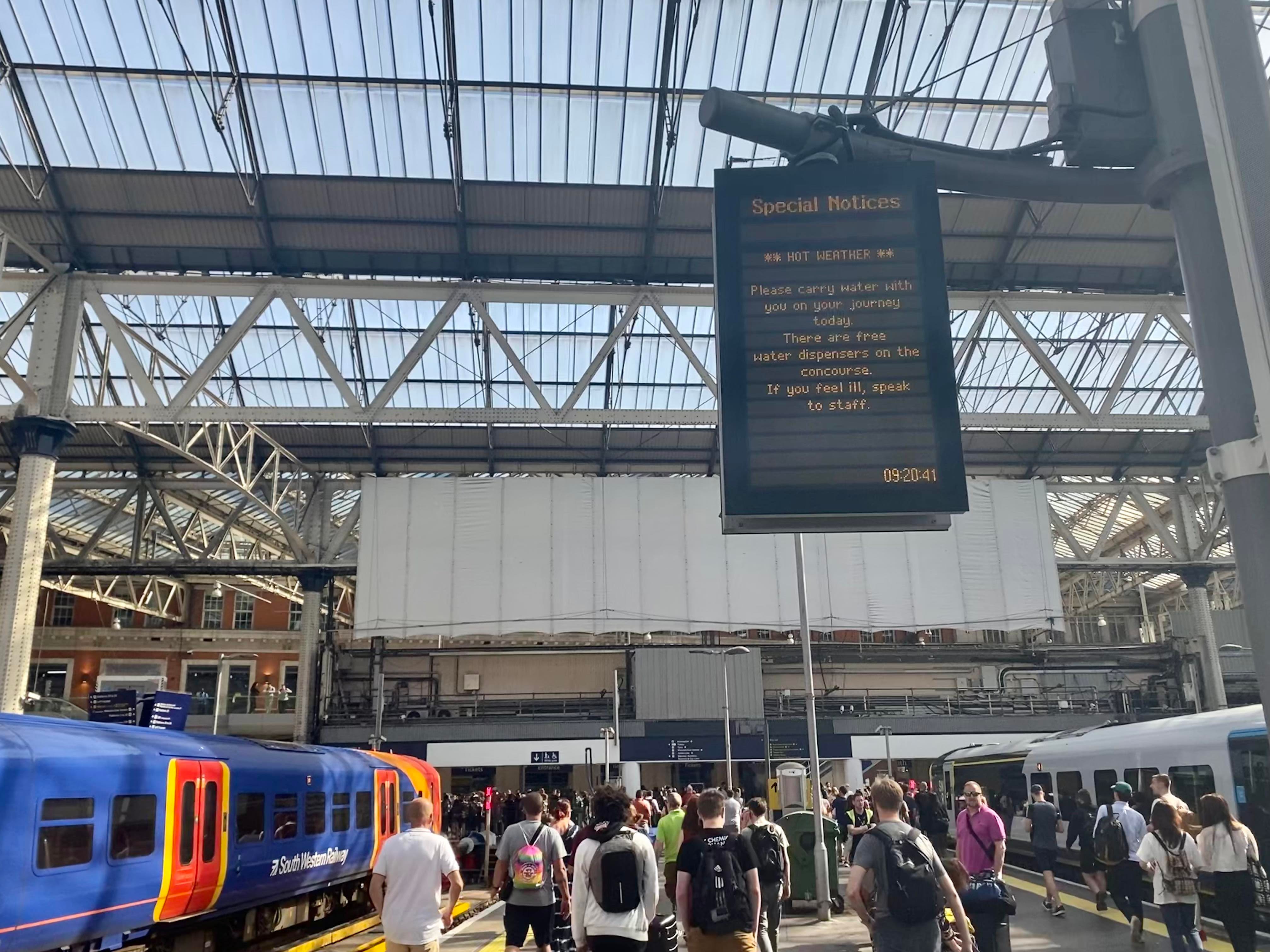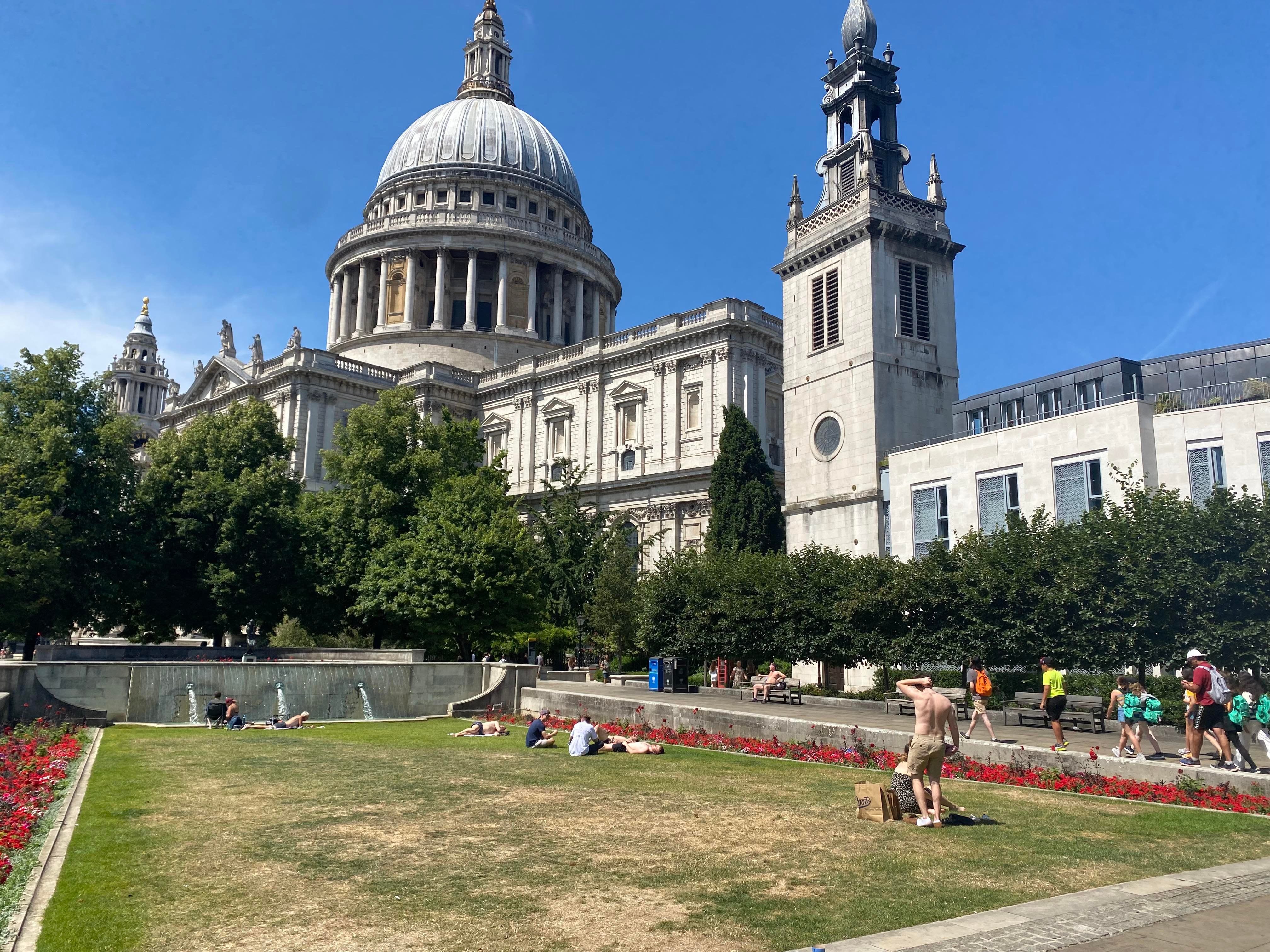London burning
Once thought improbable, 40 degrees becomes reality for the city.

In the UK, there are two ways in which large-scale weather types lead to heat waves.
The first is when a high-pressure system sits over the country for a protracted period of time. With clear skies and no clouds, the air warms as it descends through the atmosphere and is compressed, leading to a summer where the heat isn’t exceptionally hot in terms of individual days, but is a prolonged period of hot weather. This was the summer of 2018 and before that, the summer of 1976.
The second type is when a low-pressure area and high-pressure area with opposite rotations sit on either side of the UK and import a strong southerly flow of hot air from North Africa, the Mediterranean, and the Iberian peninsula.
The Spanish plume events, which Dr Simon Lee - an atmospheric scientist - coins as a "tongue of lava" (because of how they look on temperature maps), are the phenomena behind the UK's hottest days.
On the 19th of July 2022, it propelled the mercury in London to a height once thought impossible: 40.2 degrees.
For the city, it was the hottest day since records began.
For Mila Hrisimova, 26, and her one-year-old son Freddie, the heatwave was "an absolute nightmare".
Despite windows being kept open all day and a fan on blast throughout the whole night, the rooms in her Barnet townhouse became unbearably hot.
Mila herself is no stranger to the intolerable nature of heat: she spent the majority of a hot 2020 lockdown, and a subsequent summer heatwave, pregnant. This time around, her concern again centers around her son Freddie - who sleeps in a room that, during heatwaves, can get up to 30 degrees. "This is terrifying as a parent because he could get dehydrated and overheat," Mila said.
Across the city near Canary Wharf, Kate McManamon, 24, lives and works from home in a high-rise building in Tower Hamlets. It is one of the most vulnerable areas to heat in the entire country. Kate's flat "trapped" the heat, and she had only "one little fan to alleviate it." Her nearest green space was an inconvenient fifteen-minute walk away in the baking sun, not very big, and on a hot day intensely crowded. In the end, she chose to escape to her workplace: "I went into the office two of the days for the air-con as it was too hot in the flat to manage."
These two perspectives in an intensely hot forty-eight hours were echoed across the sweltering city.
Fires caught ablaze in the capital - leading to the busiest day for London's Fire Brigade since World War II. At least one person, a 14-year-old boy from Richmond, in southwest London, drowned in the dangerous waters of the river Thames in an attempt to cool down. The capital's travel infrastructure ground to a screeching halt, with services canceled and passengers on the Underground, advised to travel only if absolutely necessary.





A warning of severe weather greets passengers as they arrive in the city via London Waterloo train station. Photo credit: Samuel Hewetson
A warning of severe weather greets passengers as they arrive in the city via London Waterloo train station. Photo credit: Samuel Hewetson

London residents in the sun, outside St Paul's Cathedral. Photo credit: Samuel Hewetson
London residents in the sun, outside St Paul's Cathedral. Photo credit: Samuel Hewetson

London's Hyde Park turnt brown and parched during the prolonged dry conditions. Photo credit: Samuel Hewetson
London's Hyde Park turnt brown and parched during the prolonged dry conditions. Photo credit: Samuel Hewetson

A sign at Westminster underground tube station advising passengers to travel with water during the July heatwave. Photo credit: Samuel Hewetson
A sign at Westminster underground tube station advising passengers to travel with water during the July heatwave. Photo credit: Samuel Hewetson
At a national level, the UK government convened COBRA meetings and declared a national emergency. The Met Office announced a Level 4 Heat-Health alert for parts of England, including the capital, indicating a heatwave so severe that it causes danger to life - not just in high-risk groups, but among the fit and healthy - and impacts health and social care, transport, food, water, and energy services.
On social media, a Met Office future forecast from 2020 went viral. It showed what people could expect from the weather in summer 2050 under a high emissions scenario. Except, the prediction had just come true thirty years early.
By exceeding 40 degrees, the UK has crossed a climate Rubicon and for meteorologists like Lee, the implications are terrifying: "Not only is reaching 40 degrees celsius something previously unfathomable, but we have now experienced four of the top five hottest days in the UK in just the past four years. We have now exceeded 100 degrees Farenheit, which had only occurred before in August 2003, in 2019, 2020, and 2022. This is a grim glimpse into a hot future, where such extremes will occur more and more frequently - along with all the problems that it will cause, for which we are currently ill-equipped."
For Mark McCarthy, who manages the National Climate Information Centre at the Met Office (responsible for putting current weather into a climatological context, as well as monitoring climate variability in the UK), there is no doubt as to what is to blame for such intense temperatures: "As climate change has warmed the planet, it has also warmed the UK. The fact that we’re successively seeing temperatures of this height, and these high-temperature records being broken, that’s in part a consequence of where our heat waves originate. Those are the regions of the world that have warmed more than the global average.”
"And the heatwave that we're experiencing - if not necessarily impossible - under a natural climate would be very, very much unlikely to have occurred."
Based on one of the Met Office's studies as of two years ago, McCarthy explains that a 40 degrees celsius event in the UK is supposed to be a "one in 100 to one in 300-year" occurrence. "Return periods can be misleading because it gives the impression that we won't see it for another hundred years or so, but that's just a presentation of statistics. Sometimes you can roll three sixes in a row. So, for our current climate, it is still rare, but as we go through the 21st century, the likelihood is going to increase. It's going to become more and more likely that it will occur again."
The July heatwave was not just unprecedented in area, but in scope. McCarthy calls it "astounding". "This southerly flow meant that that hot air was really being advected up along the eastern side of the country. It was going right up into the Vale of York and then extending very far north. We were seeing 40 degrees in London, but also in Lincolnshire, Nottinghamshire. And obviously, we focus on the most extreme temperatures, but Scotland also saw its first 35 degrees on the same day, so it's pushing those temperature boundaries further and further north."
If the high temperatures of this heatwave had lasted more consecutively, over a period of a week or more - comparable to the length of the hot spell in '76 - it likely could have reproduced a disaster of the scale seen in Paris in 2003.
Instead, it was a short, sharp blast.
The worry is that the next 40-degree heatwave won't be as nearly as short, and less forgiving.
"40 degrees is just a number and there's nothing physically significant about that as a milestone. We certainly have impacts from hot weather at lower temperatures than that, and there are certain countries and relatively close neighbours that are hotter than that during the summer. But I think, psychologically, these sorts of milestones do have an impact, and act as a reminder that our climate is changing," says Mark McCarthy.
Although 40 degrees is shocking, there is an unedifying obsession with breaking records that masks the real problem. If 40 degrees hadn't been broken, people might have thought that that expectation was an exaggeration ... and the perspective would have been warped, even though climate change is still biting at the heels of the UK and the temperature is still - trending - increasing, inching forward. A temperature of 35 is about two or three times more likely to happen in London than it would have been in a natural climate so even if future heatwaves don't break a record, it’s still another example of an exceptionally hot day in the UK’s heating climate and that’s the key thing.
"It's news-grabbing to talk about the record and it's exciting, but breaking records and getting right to the top of the climate ... that's not so much representative of a large-scale climate shift, because that's a rare event - like rolling great sets of dice or having great hands in cards repeatedly - but when you are getting nearer and nearer towards the top so much easier, that's concerning," says Simon Lee.
But talking about these milestones can also be useful in convincing the public of the seriousness, says McCarthy, calling it a "powerful" part of providing the "context" needed when we talk about adaptation and mitigation and part of the message for why its important. "In earlier climates, we would have looked at sort of 35 degrees as being a fairly extreme summer temperature, say 20-30 years ago. But now we're looking at sort of 38 to 40, as the more extreme summer temperatures, what implications does that have, particularly for infrastructure that has a lifespan that is much longer than that so and the infrastructure we're putting in now? How do we ensure that that will still be safe and fit for purpose in another 30 years, 30 years time? So I think in that context, these sorts of events are, are whether it, whether you call it a wake up call or whatever they are, but they are part of the story, part of the narrative of and reminder of why we are sensitive to the sorts of extremes.
We’re not a cold country. We need to be adaptable to summer heat as well. 40 degrees can't be reversed, but we can try to stop getting higher.
Mila Hrisimova wanted to buy an air-con system for her home, to adapt it, but says that "the unit cost and installation are just something that's unattainable." There is a long way to go bridging the huge heat disparities within the UK, and London.
